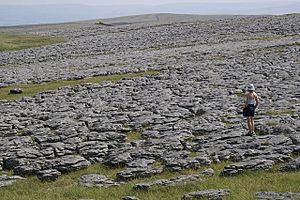Great Asby Scar facts for kids
| Site of Special Scientific Interest | |
 |
|
| Area of Search | Cumbria |
|---|---|
| Coordinates | 54°28′39″N 2°32′46″W / 54.4774°N 2.546°W |
| Interest | Biological/Geological |
| Area | 1.35 square miles (350.2605 ha) |
| Notification | 29 May 1986 |
| Location map | Magic Map (Defra) |
Great Asby Scar is a really special place in Cumbria, UK. It's known as a Site of Special Scientific Interest (SSSI) and also a National Nature Reserve. This means it's protected because of its unique nature. It's famous for its amazing limestone pavement, which is a type of rocky landscape. You can find it just south of the village of Great Asby.
Contents
What is a Limestone Scar?
A "scar" is a local word for a limestone pavement. Imagine a flat area of limestone rock. Long, long ago, during the Last Glacial Maximum (the Ice Age), a huge sheet of ice moved over this rock. This ice smoothed and shaped the limestone.
After the ice melted, rain started to fall on the rock. Over thousands of years, the rain slowly carved cracks and patterns into the limestone. This created a flat, rocky surface that looks a bit like a man-made pavement.
Many limestone pavements in the UK have been dug up for their stone. But Great Asby Scar is special because it's still very large and mostly untouched. The whole area of these pavements covers about 15 square miles (39 km2). This larger area is called the Westmorland Scars. Great Asby Scar is right in the middle of it. Other nearby scars include Orton Scar and Little Asby Scar.
Protecting Great Asby Scar
Great Asby Scar is located in the Orton Fells. This area is part of the district of Eden, close to the village of Great Asby.
This special place was first named a Site of Special Scientific Interest (SSSI) in 1969. This protection covers an area of about 864 acres (350 ha). Later, in 1976, it also became a National Nature Reserve. This part of the protection covers about 409.5 acres (165.7 ha). These titles mean the area is important for its wildlife and geology, and it's protected by law.
There's also an old walled settlement here called Castle Folds. It's built on a small flat area, about 1.25 acres in size. This settlement dates back to Roman times. Because it's so old and important, it's protected as a scheduled monument.
Plants of Great Asby Scar
The landscape here is a mix of different types of grasslands. You'll find both acidic and alkaline grassland. The main grasses you'll see are blue moor-grass and matgrass.
Many other plant species live here too. Some rare types of buckler ferns and limestone ferns can be found. Because the area is quite open and windy, plants often grow in the cracks between the limestone blocks. These cracks are called grykes.
Some of the notable plants that thrive in these sheltered grykes include autumn gentian, different kinds of helleborines, and Solomon's Seal.
Animals of Great Asby Scar
The area might look a bit bare, but it's home to some interesting creatures. The most famous animal here is a very rare snail. Its scientific name is Vitrea subrimata. This tiny snail is a special resident of Great Asby Scar.

